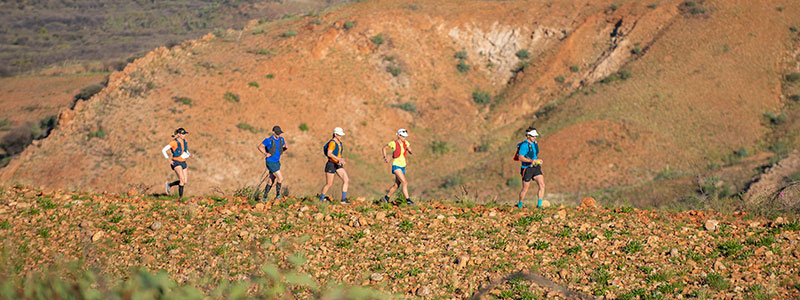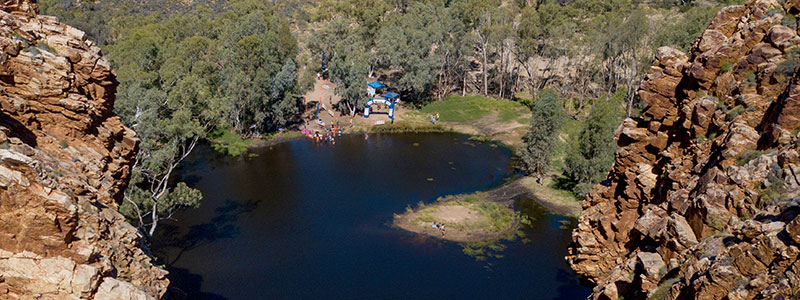
Can’t find the answer below? Please contact our office via [email protected] or (03) 5261 5511 for assistance.
How do I use my credit from a previous event?
Please email [email protected]. You will be sent a voucher code to redeem your credit.
What is the difference between a ‘Four-Stage Runner’ and a ‘Single-Stage Runner’?
A ‘Four-Stage Runner’ is participating in all 4 stages over the 4 days. All four stages must be the same – i.e. the short course (Namatjira) OR the long course (Malbunka).
A ‘Single-Stage Runner’ is doing 1 or 2 or 3 or 4 stages, in either the long or short courses, over the four days, .
What does the PACKAGE option include?
- 4 Stage Race Entry to The Malbunka/The Namatjira
- Race Transfers (transfers to and from the start and finish lines, PLUS transfers to and from the airport and Alice Springs before and after the race on 14th or 15th Aug and 19th Aug)
- Ticket for the BBQ Dinner following Stage 1 & 2 Presentations, held after Stage 2
- Ticket for the Presentation Dinner on final day of racing (following Stage 4)
- How can I join the dedicated Run Larapinta Past and Present Facebook group?
Connect with other participants before, during and after your event, ask questions about the event, share tips and ideas, compare experiences and get to know each other before your race. CLICK HERE to join the conversation!
How will I be able to tell the difference between the ‘Four-Stage Runners’ and ‘Single-Stage Runners’?
Competitors running the Malbunka will have a red race plate. Those doing all four stages will have a number between 1 and 200. Those participating as a single stage runner will have a number between 300 and 350.
Competitors running the Namatjira will have a yellow race plate. Those doing four stages will have a number between 400 and 600; while those doing a single stage(s) will have a number between 700 and 750.
Can I change from a ‘Four-Stage Runner’ to a ‘Single-Stage Runner’?
Yes – you can drop down from a Four-Stage Runner prior to the event or during the event. You will not receive a refund.
Please note you will not be eligible for General Classification prizes.
You will still be eligible for the Stage Winner prizes.
Can I upgrade from a ‘Single-Stage Runner’ to a ‘Four-Stage Runner’?
Yes, of course! Please note to qualify for General Classification you must be entered as a ‘Four-Stage Runner’ prior to race one. Please contact [email protected] to make a change to your race entry.
Am I good enough to do the event?
Most likely – but you have to be determined.
While we do encourage runners of differing ablities to do the race, all participants need to undertand that the terrain is tough, rocky and relentless. You DON’T NEED TO BE FAST but you do need to be determined and capable of keeping on going when things get hard.
The race includes stages of two different lengths so runners can select the set of stages that matches their running ability and objectives. Whilst Run Larapinta is primarily designed for runners to complete all 4 stages of a given event, runners may also enter individual stages – so you can tailor the event to suit your needs. Or you can just enter 1 or 2 stages only.
Note – there are specific entry qualifications to compete in the Malbunka (long course). Please review our Entry Qualifications and Requirements prior to entering – CLICK HERE for more. Contact [email protected] if you have any questions.
I am unable to participate – where can I view the Refund Policy?
Please CLICK HERE to view the refund policy. This will be strictly enforced.
I need to update my contact details – how do I do this?
You can login to your entry to update your personal details here. Alternatively, please email [email protected] to notify us of any updates.
Where do I find a list of compulsory items?
CLICK HERE for more information on Equipment, Rules and Safety.
How do I get to the start line and back from the finish line?
You can book a full Race Transfers package during the registration process. This ensures you get a lift to all starts and back from all finishes. Full details around race transfers are available here.
Where can I find further information about Travel and Accommodation in Alice Springs?
Click here for further information on accommodation and visiting Central Australia.
Do I have to stay In the recommended accommodation?
No – you don’t have to.
Whilst not mandatory, it’s certainly easier to stay at the recommended accommodation as the race transfer buses pick up and drop off from these locations. Most competitors stay here – it’s a fun atmosphere!
Mercure Alice Springs and Discovery Parks Alice Springs have provided some great rates for competitors. For more information click here

What category will I be racing in?
CLICK HERE for further information on Categories and Prizes.
What is the Malbunka?
The Malbunka is the name given to the long course race at Run Larapinta, with stages of 20-45km each day.
It’s been named after Hezekiel Malbunka, an Indigenous stockman, who ran 126km from Hermannsburg (originally a Lutheran Mission and now Aboriginal community) on the Finke River in the MacDonnell Ranges to Alice Springs in order to save the life of missionary administrator, Carl Strehlow (1871–1922).
Regarded as one of Australia’s most important anthropological experts on the local Arrernte and Luritja Indigenous cultures, Strehlow lay dying at the mission homestead. As horses were being saddled to dispatch a message to the Telegraph Station at Alice Springs requesting medical assistance be sent from Adelaide, Malbunka declared that he would go faster on foot.
It took Malbunka only a day and a half to run the 126km to Alice Springs, quicker than station hands agreed could have been achieved by their horses. Incredibly, he then turned around and ran back, taking only a day to return.
Read more about Carl Strehlow on Wikipedia.
What is the Namatjira?
The Namatjira is the name given to the short course race at Run Larapinta with stages of 10-30km each day. It’s been named after Indigenous identity Albert Namatjira.
Albert Namatjira (1902–1959) was a Western Aranda-speaking Aboriginal artist from Hermannsburg in the western MacDonnell Ranges in Australia. As one of the most prominent Aboriginal artists of the time, he was a pioneer of contemporary Indigenous Australian art.
His watercolour Australian outback desert landscapes were of the Hermannsburg School of Aboriginal art. With their richly detailed watercolour depictions, the predominantly western style departed from the highly symbolic style of traditional Aboriginal art whilst drawing upon personal experience.
Namatjira is also symbolic of the Australian Indigenous rights movement and the bridging of Australian cultures, being the first Northern Territory Aboriginal person to be freed from the restrictions of legislation that made Aborigines wards of the State, becoming the first Aboriginal person to be granted Australian citizenship in 1957.
Read more on Albert Namatjira on Wikipedia.
Please contact our office via [email protected] or (03) 5261 5511 if you have any queries.


